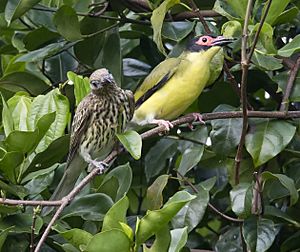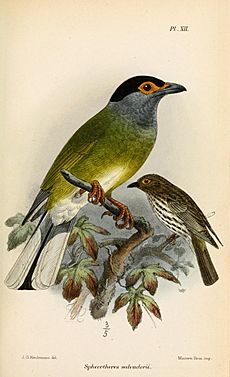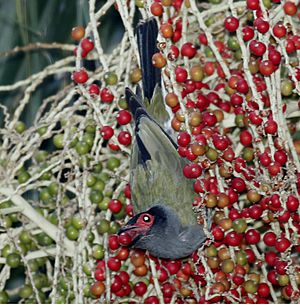Australasian figbird facts for kids
Quick facts for kids Australasian figbird |
|
|---|---|
 |
|
| A pair in Queensland, Australia (female on left; yellow variant on right) | |
| Conservation status | |
| Scientific classification | |
| Genus: |
Sphecotheres
|
| Species: |
vieilloti
|
| Synonyms | |
|
|
The Australasian figbird (Sphecotheres vieilloti) is a colorful, medium-sized bird. It is also known as the green figbird. You can find it in many wooded areas. These include northern and eastern Australia, southern New Guinea, and the Kai Islands. This bird is quite common in its home areas. It lives in many protected places. Because of this, experts say it is a species of "Least Concern." This means it is not currently at risk of disappearing.
Contents
About the Australasian Figbird
The Australasian figbird used to be thought of as a type of Green figbird. People just called it the figbird. This name is still common in Australia. The Australasian figbird was later seen as its own species. This was based on how big it was and its feathers. Also, where it lived helped show it was different.
Sometimes, the Australasian figbird was even split into two species. These were the yellow figbird (S. flaviventris) and the green figbird (S. vieilloti). But these two types often mix where they meet. This shows they are likely just one biological species.
Different Types of Figbirds
There are five recognized types, or subspecies, of the Australasian figbird:
- S. v. salvadorii: This type lives in south-eastern New Guinea.
- S. v. cucullatus: You can find this type on the Kai Islands. These islands are off south-western New Guinea.
- S. v. ashbyi: This type lives in northern Western Australia and the Northern Territory, Australia.
- Yellow figbird (S. v. flaviventris): This type is also called the northern figbird. It lives in north-eastern Australia and the Torres Strait Islands.
- S. v. vieilloti: This is the main type. It lives in eastern Australia.
What Does It Look Like?
The Australasian figbird is about 27 to 29.5 centimeters (10.6 to 11.6 inches) long. It looks similar to other orioles. Male and female figbirds look different. This is called sexual dimorphism. The differences are mostly in the males.
Males of all types have a black tail with white tips. They have white feathers under their tail. Their main wing feathers are blackish. They have a black head with bright red skin around their eyes. Their beak is black with a red base. Their legs are pinkish.
- The main type of figbird is mostly olive-green. Its throat, neck, and chest are grey.
- Other types like cucullatus, ashbyi, and flaviventris are yellowish-olive green on top. They are bright yellow underneath.
- The salvadorii type is similar to the yellow ones. But it has a grey throat, collar, and chest. This makes it look like a mix between the main type and the yellow type.
Female figbirds are duller in color. They are brownish on top. They are white underneath with dark stripes. They have greyish skin on their face. Their beak is greyish-black. Young figbirds look like females. But their stripes are usually not as strong. Other orioles in the area look a bit similar. But adult orioles have completely red beaks.
Australasian figbirds make many different short calls. They can also copy the sounds of other birds. This includes parrots and other orioles. Their song is a series of simple whistles.
How Figbirds Live
As their name suggests, Australasian figbirds mostly eat fruit. But they also eat small insects, nectar, and tiny seeds. These birds usually stay in one area. However, the southern birds might move around. They travel to find food when it is available.
Unlike most orioles, Australasian figbirds like to be in groups. They often form flocks of 20 to 40 birds. This happens when they are not breeding. They even build their nests in small, loose colonies. Their nest is like a flimsy, saucer-shaped cup. It is made from plant material. They usually place it high up in a tree.
Both parents take turns sitting on the eggs. They usually lay two to four eggs. The eggs hatch after about 16 to 17 days. These birds have been seen nesting near aggressive birds like the spangled drongo. This might help them. These aggressive birds can keep away animals that might eat their eggs. Sometimes, Pacific koels lay their eggs in figbird nests. This is called nest parasitism. The figbirds then raise the koel chicks.
See also
 In Spanish: Oropéndola de Vieillot para niños
In Spanish: Oropéndola de Vieillot para niños




